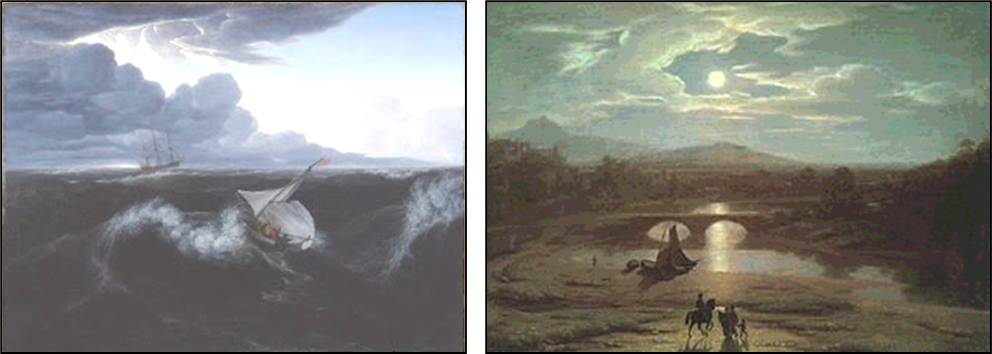


xxxxxThe French painter Théodore Géricault is especially famous for his The Raft of the Medusa of 1818, a scene from a real-
THÉODORE GÉRICAULT 1791 -
(G3b, G3c, G4)
xxxxxThe French painter Théodore Géricault, an artist of outstanding talent, is remembered above all for his The Raft of the Medusa, begun in 1818 and exhibited a year later. This vast, impressive canvas, together with his realistic portraits of the insane in the early 1820s, removed French art from the sterile neoclassicism of the Napoleonic era, and, following on from the works of Antoine Jean Gros, marked him out as the true precursor of the romantic movement. He it was who answered the call of the young reactionaries: “Who will deliver us from the Greeks and Romans?”
xxxxxGéricault, born into a wealthy family in Rouen, began his training as an artist at the age of 17. He first studied under Carle Vernet, a painter who specialised in hunting and racing scenes, and then in 1810 became a pupil of the academician Pierre Guerin, studying figure construction and composition. It was at this stage that he came to admire the works of his older colleague Antoine Gros, an artist famous for his gung-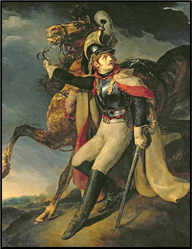 ht
ht 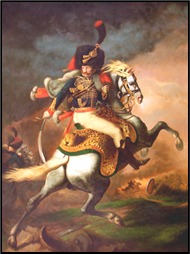 from the palette of the Flemish artist Rubens, it typified the daring, dash and determination of one of Napoleon’s cavalry officers in action. Its vitality created a sensation. However, he followed this up two years later with his Wounded Cuirassier, a companion work which, in marked contrast, was sombre in both mood and colour, doubtless reflecting Napoleon’s declining fortunes. A lone soldier limps off the battlefield, not so much a hero as a figure of suffering and endurance (
from the palette of the Flemish artist Rubens, it typified the daring, dash and determination of one of Napoleon’s cavalry officers in action. Its vitality created a sensation. However, he followed this up two years later with his Wounded Cuirassier, a companion work which, in marked contrast, was sombre in both mood and colour, doubtless reflecting Napoleon’s declining fortunes. A lone soldier limps off the battlefield, not so much a hero as a figure of suffering and endurance (
xxxxxIn 1816 Géricault left Paris and went to Italy, visiting both Rome and Florence. Here he was deeply impressed with the beauty and vibrancy of Renaissance art. One account tells of his “trembling” with wonder when contemplating the works of Michelangelo. While in Rome he produced a large number of drawings depicting classical scenes and contemporary subjects, and these testified to his outstanding talent as a graphic artist. And having witnessed the race of riderless horses, held during the city’s annual carnival, he contemplated a monumental canvas to capture the sheer beauty and movement of this powerful event. He made numerous sketches for this would-
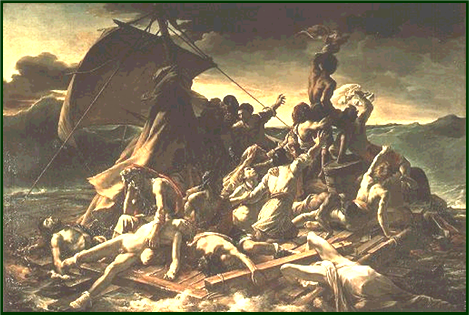 xxxxxIt was on his return from Italy in 1818 that Géricault began work on his famous painting, The Raft of the Medusa. This was a remarkable canvas for a number of reasons. Firstly, it was closely based on a real-
xxxxxIt was on his return from Italy in 1818 that Géricault began work on his famous painting, The Raft of the Medusa. This was a remarkable canvas for a number of reasons. Firstly, it was closely based on a real-
xxxxxThirdly, Géricault conveniently captures this grim tale at the dramatic moment when a ship appears on the horizon and when, for those still conscious, despair and suffering give way to hope and joy. Furthermore, the emotional intensity of this scene, full of compassion and heroic endeavour, is highlighted by the brilliant composition of the figures, the ray of light upon the tortured bodies, the leaden sky, the tossing sea, and the outstretched arms. In theme and treatment it had all the requirements of pure romanticism and -
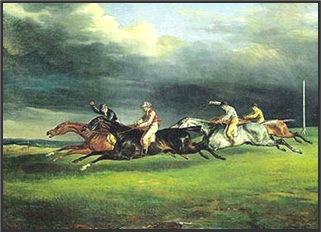
xxxxxAt the Paris Salon of 1819 this vast, grandiose painting (measuring 23ft by 16ft) was not well received. Initially, its political undertones, its size and unorthodox methods of production, and its disturbing mixture of realism and idealism, found little favour with the general public and, as to be expected, attracted nothing but abuse from the adherents of neoclassicism. Disillusioned and depressed, Géricault paid a visit to England in 1820 and found a measure of consolation. There and in Ireland his masterpiece was well received, as were the sporting prints he produced, and his watercolours and lithographs of London street life. Amongst his works at this time were an equestrian portrait of the Prince Regent, and The Derby at Epsom of 1821 (illustrated). While in England he was particularly impressed by the works of John Constable and Richard Parkes Bonington.
 xxxxxHe returned to Paris in 1822, and it was then that he painted a series of five realistic portraits of mentally ill patients in the Salpêtrière Hospital. Such an unusual, disturbing subject was in keeping with romanticism, but, in fact, they were executed at the request of a psychiatrist in order to illustrate different varieties of mental illness. (One of the five, a kleptomaniac, is shown here). By this time, however, Géricault was himself in poor health. A depressive by nature, he was taken seriously ill early in 1823, an illness aggravated by a riding accident, and after several months of suffering, borne stoically, he died in January 1824, aged 33. The genre paintings he produced shortly before his death, such as The Lime Kiln, are forbidding and bleak, in keeping with his own disturbed state of mind. It is shown below together with Self-
xxxxxHe returned to Paris in 1822, and it was then that he painted a series of five realistic portraits of mentally ill patients in the Salpêtrière Hospital. Such an unusual, disturbing subject was in keeping with romanticism, but, in fact, they were executed at the request of a psychiatrist in order to illustrate different varieties of mental illness. (One of the five, a kleptomaniac, is shown here). By this time, however, Géricault was himself in poor health. A depressive by nature, he was taken seriously ill early in 1823, an illness aggravated by a riding accident, and after several months of suffering, borne stoically, he died in January 1824, aged 33. The genre paintings he produced shortly before his death, such as The Lime Kiln, are forbidding and bleak, in keeping with his own disturbed state of mind. It is shown below together with Self-
G3c-
Acknowledgements
Géricault: The Charging Chasseur – The Louvre, Paris; The Wounded Chasseur – The Louvre, Paris; The Raft of the Medusa – The Louvre, Paris; Epsom – The Louvre, Paris; Kleptomaniac – Museum of Fine Arts, Ghent, Belgium; The Lime Kiln – The Louvre, Paris; Self-
xxxxxApart from his work in oils, Géricault was a talented graphic artist, with a remarkable ability in capturing animals in movement. He produced some superb lithographs -
xxxxxIncidentally, the Medusa was one of four ships that set sail for Senegal in June 1816. The squadron was commanded by Viscount Hugues De Chaumereys, a man with very little naval experience. His flag ship, the Medusa, was carrying some 400 men, women and children, including the new Governor of Senegal and a crew of 160. In order to reduce the length of the voyage De Chaumereys chose to sail close to the African coast, despite warnings from more experienced sailors.
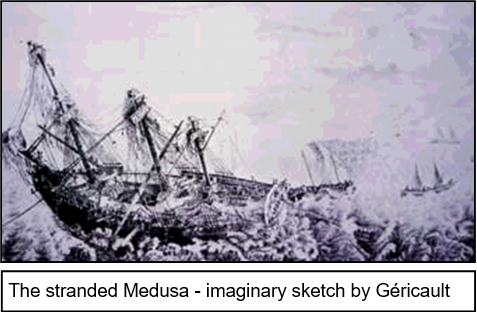 xxxxxAt the beginning of July the ship ran aground on the notorious Arguin Bank, some thirty miles off the West African coast. Obliged to abandon ship, he put his senior officers and passengers in the five lifeboats and constructed a make-
xxxxxAt the beginning of July the ship ran aground on the notorious Arguin Bank, some thirty miles off the West African coast. Obliged to abandon ship, he put his senior officers and passengers in the five lifeboats and constructed a make-
xxxxxAs for De Chaumareys, he was court-
Including:
Washington Allston

xxxxxIn the United States the pioneer of romantic art was the painter Washington Allston (1779-
xxxxxThe beginning of Romantic art in the United States owes much to the painter Washington Allston. Born near Georgetown, South Carolina in 1779, he graduated from Harvard University in 1800, and then travelled to Europe. He studied with Benjamin West at the Royal Academy in London over the next three years, and then continued his studies in France and Italy. As a romantic, his historical scenes -
xxxxxHe worked for seven years in London before returning to Boston in 1818, where he became regarded as the pioneer of the American romantic movement. He eventually settled in Cambridgeport, Massachusetts in 1830, and it was there that he died in 1843. Apart from painting, Allston also produced a book of poems, and he was a close friend of the English poet Samuel Taylor Coleridge during his stay in Italy.

